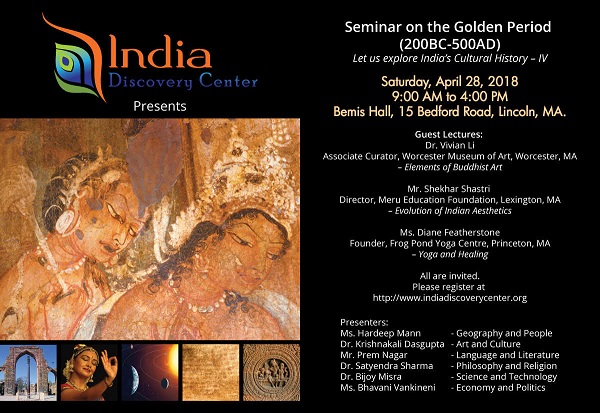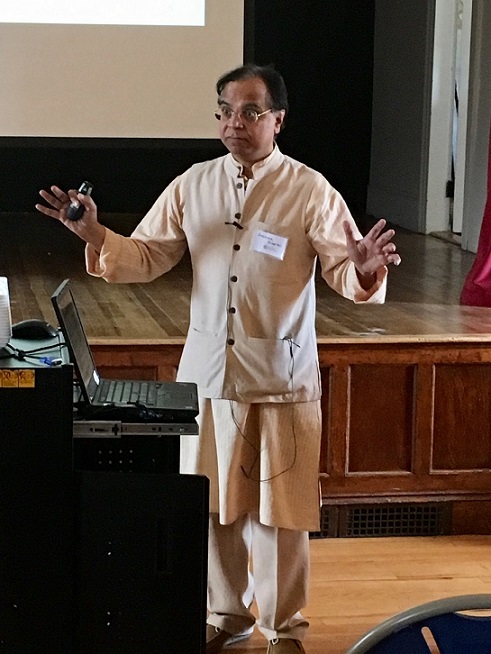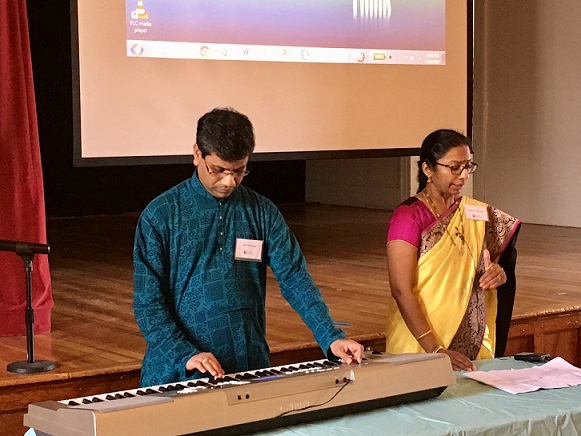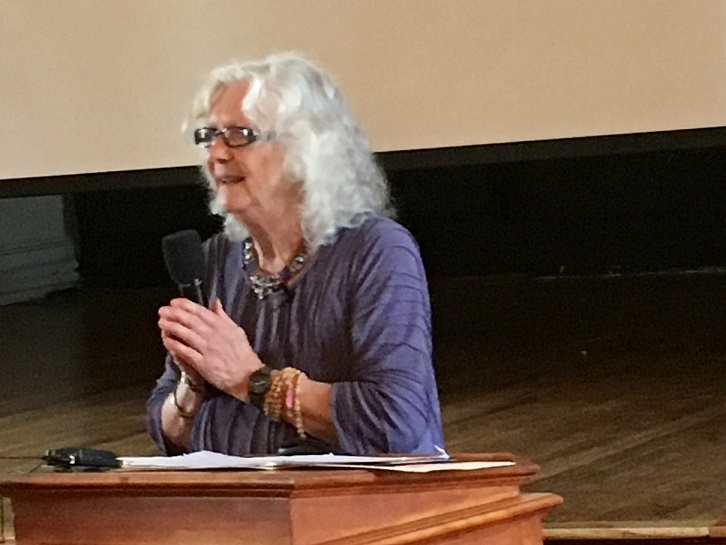Contribute
|
Aesthetics And Analysis - The Story Of Golden Period In India 200BC-500AD Part I - Guest Lectures, Music, Recitation And Public Forum |
Prem Nagar
05/17/2018
“Aesthetics and Analysis†– The Story of Golden Period in India 200BC-500AD Part I – Guest lectures, Music, Recitation and Public Forum It was the fourth seminar hosted by the organization. This report is in two parts. In the first part we give the summary of the guest lectures, parts of music and recitation. In the second part we give the summary of the presentations. The presentations were in six tracks as followed in the previous seminars http://www.indiadiscoverycenter.org/seminars. There was a book display arranged to popularize literature of the period. The President of the organization, Dr Bijoy Misra welcomed all guests and recognized the work of all volunteers. He introduced Dr Sonal Jhaveri of MIT, who moderated the day’s program. The program commenced with the choir presented from the Syro-Malabar Catholic Church in Framingham to symbolize the arrival of St Thomas in India in 52 AD. The group was led by Mr Joseph Kunnel on keyboard and voice rendered by Mr. Anil Varghese, Ms. Tresa Francis, Ms. Villbeena Kunnel and Ms. Smitha Depin. In two devotional prayer songs in Malayalam, the choir sang the bounties of the land and worshipper’s desire of extreme humility. The congregation was blessed by Dr. P. M. John, the octogenarian leader of immigrant Kerala Christians in Boston area. The first invited talk “Buddhist Art†was delivered by Dr. Vivian Li, the Associate Curator of Worcester Art Museum, Worcester, MA. Born and raised in Taiwan, Dr. Li took interest in art and art history and has been a leading curator in South Asian Art. She explored the intricacies of design and use of color in the frescoes of Ajanta Caves. She pointed out the dedication and sincerity of the artists, who were most likely the Buddhist monks in residence. She commented on the architectural design of the caves and the arrangement of pictures and statues. It was a welcome tutorial on the design and art in ancient India. Following the lecture, we had the presentations on “Geography and People†and “Language and Literature†(Please see Part II). Then Ms. Srilakshmi Srinivasan gave a voice rendering of the selected stanzas from the Poet Kalidasa’s Kumarasambhavam. Kalidasa lived around 5th century AD and is considered the greatest poet of India, compared to William Shakespeare in the west. Kalidasa’s material, style and poetic effects are legends in world literature. The beautiful stanzas animated the mountains and imagined the birth of the Earth Mother from the mountains. Ms. Srinivasan was accompanied by Dr. Ravi Mosurkal on synthesizer. The next guest lecture on the topic “Evolution of Indian Aesthetics†was offered by Mr. Shekhar Shastri of Meru Education Foundation in Lexington, MA. Mr. Shastri is a teacher and art enthusiast. He traced the aesthetics of the Vedic fire rituals and connected them to the expression of drama. He went through Panini’s coding in Astadhyayi and Bharata’s coding in Natyashastra. He emphasized the importance of “rasa†as a “take home†effect through the experience in an interaction. Finally, he demonstrated the distinction between the physical gestures against aesthetic realization. After two more presentations on “Philosophy and Religion†and “Art and Cultureâ€, Dr. Charlie Lindley, the psychiatrist and Sanskrit teacher, recited a couple of hundred sutras from Panini’s Ashtadhyayi. He is one of the very few in the US who have made efforts in learning Paninian grammar from a teacher in India. His rendering was flawless. His memory appeared to be dynamic like the Vedic reciters in the tradition. We had the presentation on “Science and Technology†leading to a guest lecture on “Yoga and Healing†by Ms. Diane Featherstone, the founder of Frog Pond Yoga center in Princeton, MA. With long years of practice and training, Ms. Featherstone conveyed her conviction that the results of yogic exercises are experienced internally resulting in mental peace and sound physical health. With drawings of human nervous system, she explained how pain is relieved through coded muscle exercises. The final presentation was on “Economy and Politics†and the floor was open for a “Public Forum†entitled “Learning from India’s Culture and Educating the Public.†R. Balachandra, Professor Emeritus in Northeastern University, presided the Forum. The topics ranged from dress, religion, language and children. There were comments on culture retention and propagation. All agreed on the need of communicating values of the culture to the children. The final music piece of the day was a beautiful Dhrupad composition entitled “Ode to Sri Saraswati†rendered by Mr. Shekhar Shastri. It was the fitting culmination to the day of discovery. The lunch was supplied by the Holi Restaurant in Bedford, MA. The food arrangements were supervised by Ms. Radha Jalan, Ms. Bhavani Venkineni, Ms. Neena Wahi and Ms. Hardeep Mann. The book display was coordinated by Mr. Chandramouli Subbaraman, with some books loaned from Mr. Kaveesh Mishra’s personal collection. Mr. Chandu Shah helped with the brochure graphics and printing. Dr. Satyendra Sharma offered a Vote of Thanks on behalf of India Discovery Center. Acknowledgement was due to the Council of Aging in Lincoln for the facilities and the assistance. Mr. Leo Rousseau was acknowledged for his help with video-recording and Chow-Chin Chou for site management and photography. Dr. Anil Saigal of Lokvani was acknowledged for his help with the media. Gratitude was expressed to all participants and the attendees. The next seminar for the Hindu Period 500AD-1500AD is scheduled for November 3, 2018 at Bemis Hall. India Discovery Center welcomes volunteers to participate in its mission. Please contact Dr. Bijoy Misra at misra.bijoy@gmail.com or Dr. Satyendra Sharma at satyendras@hotmail.com with comments or suggestions.
On a cool Spring morning, after a prolonged New England winter, about eighty people converged at Bemis Hall in Lincoln, MA, to help reconstruct the cultural history of people of India for the period 200BC-500AD, termed as the Golden Period. The group included teachers, students, artists, historians, scientists and social activists both of Indian and western origin – all having deep interest in India through travel, education, art, philosophy or literature. The event on April 28, 2018, was organized by India Discovery Center, a Lincoln-based non-profit organization, that is engaged in creating educational material on Indian culture and civilization for the youth and the public.
You may also access this article through our web-site http://www.lokvani.com/



